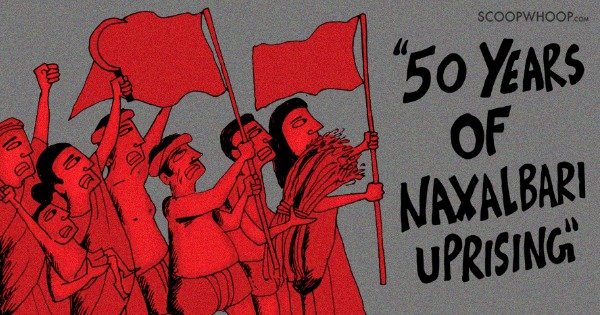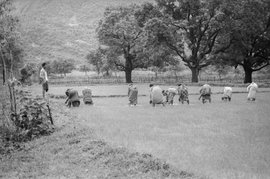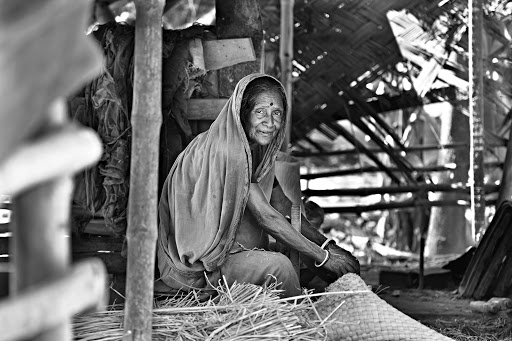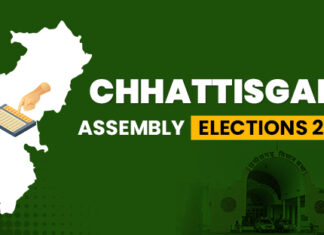As the Naxalbari uprising in 1967 set fire to what had so long been simmering in the hinterlands of Bengal ever since the Tebhaga movement, villages across the North Bengal, Mednipore and Bolpur belts became battlegrounds. With all the public places in and around one’s home becoming arenas where battles of caste, class, gender, and land rights were being fought, it became exceedingly difficult to keep the private and public realms separate and thereby keep oneself insulated from what was happening around oneself. Thus, in order to study the nature of women’s participation in the Naxalbari movement, one needs to understand that for rural women locked in a space where the entire village had transformed into a battleground, participation was not really a matter of choice.
The turbulence of the time, the revolutionary space created by the movement made a dent in the societal fabric too. Through these cracks in social rigidity, women started making way into the movement. For many, these were ‘magical’ and ‘wondrous’ times. Times when many options became viable, the chance to transcend the quotidian existence that social norms have marked for them and live another life. The time had brought with it the possibility to connect oneself with the wider world outside.
Shanti Munda speaks of tales from those times when the situation demanded of the women to take up important roles in the movement. When the men of the village had to go underground, these women kept the network alive. “Many more women like me had joined. Galeshwari, Etowari, Rajkot, Noni, Kishan, Ganga, Hasda- wherever we went we organised people. We used to gherao courts and seize land. I used to teach women how to shoot. If the police came, we would attack them with whatever we had like a knife, machete, ax,e etc. since we did not have guns. We would gherao the police every time they came to arrest someone.” The women who had been kept away from plowing the field through the imposition of various superstitious beliefs began to take up those works as those rules began to slacken. Suniti spoke about Galoshwari Tharu who plowed the field with her daughter-in-law and other village women.
Also read: Emergence of Brahminical Fascism in West Bengal
Curiously, patriarchal assumptions in the society too opened possibilities for women. Sabitri says how patriarchal ideas and structure have been used tactically, “At that time women were of greater use to the organizational works. Since women were thought to be ‘helpless’, and ‘naïve’, they could reach those places men could not go without attracting much attention. For instance, in places where there were other political parties at work, it was difficult for the men to go and talk to people there. Women could go and talk to the women there without raising much suspicion and that facilitated the growth of the organization.”
The stereotypical notion that perceived women as ‘innocent’, incapable of participating in insurgencies, helped the women carry out their political activities without attracting the suspicion of the police.
Stories of men disguising as women to avoid police attention further validate the argument. Shanti shared how this social practice of limiting women to roles of only ‘mother’ or ‘daughter’ helped the movement,
“When the police conducted combing operations, we all had to flee. My little children would hide amid the crops. Once I had to run with my 15 days old daughter. After running for a long time, I was checking whether my daughter was alive after going through so much jerking. While I was trying to regain her consciousness by sprinkling river-water on her face, the police had already reached us. One of them said, ‘Maa you go home, we will not do anything. We also have mothers and daughters in our homes.’”
Also read: Pratidhvani a Kannada News Portal Approaches High Court Against New IT Rules, 2021

In remembering one’s ‘revolutionary’ days, memories of ‘meetings’ come up very frequently. Meetings offered women the space to come out into the public sphere, to find their voice in the political arena. Sabitri recounts, “Once a meeting ended very late. I was returning alone and reached home around 12 am. My husband asked me why I was so late. I replied, ‘You ask us to go to the meetings leaving our child. How can I return before the meeting ends or should I just attend half of it.’ I have never been to my maternal home without my child but I have attended meetings like that.” Shanti recounts how the experiences of Chinese women inspired them to start a separate women’s organization,
“We would mobilize women, raise consciousness about the situation in our country and discuss the ways women could participate in this struggle. We were able to mobilize 7000 women once in Bagdogra… of this one can be certain that of women do not come forward, men would not be able to accomplish anything on their own no matter how knowledgeable or rational they are.”
She also shared how women campaigned for loans. Being barred from the crucial task of plowing the land, women even organized themselves to demand tractors. Conversations around dowry, division of household work, violence were on. Suniti recounts another story,
“We once gheraoed the police station to campaign against objectification of women in movie posters. We told them do women not have dignity. The men are all well-dressed while the women are scantily clad. Are women’s dignity in any way of lesser importance than that of men?”
Although such campaigns often ran the risk of veering towards problematic terrains due to its moralistic overtones, it is fascinating to see how the issue of objectifying women was argued upon by peasant women in the hinterlands of Bengal through a rhetoric born out of their own everyday experiences and interactions. In Gopiballabhpur though, although peasant women played a vital role in the ‘dhan kata andolon’ (seizing the harvest), as soon as the movement shifted underground, most women were left out . In case of meetings too, many women (who had hardly received any education), confided, since Bengali was the common medium of communication, those unable to understand or articulate in it, felt alienated from the movement.
Also read: West Bengal: How Hindutva Organizations Rose during Left Front Govt. Rule

The revolutionary moment also offered many women the opportunity to experience a different kind of life. One could see the glint in Leela’s eyes as she talked of the days of armed struggle, the thrill of holding a rifle, how it made her feel invincible, “I had become such an expert that I would tell them as long as I had my weapon with me no one will be able to catch me. Whenever they saw us, they gheraoed us. Once we were cleaning the rifles, when the police gheraoed us. One of my comrades fled, the police asked me to halt. But they couldn’t catch me…even the CRPs were in awe. They exclaimed that Leela Kishan could shoot so well that she could even defeat the trained CRPs… I was able to flee from that scene”. Shanti’s most prominent memory is that of fleeing from the clutches of the police in disguise. In Kuni’s memory many of these actions meant avenging the deaths and injury of their fellow comrade. Many women from Gopiballabhpur shared that while the confines of family, societal norms restricted them in participating in the armed struggle (hanrakata), it was by rallying with their comrades later, that they could express their solidarity, assert their political agencies.
Stories of the ‘magical days’ of the movement, quite easily conflated with stories of friendship, comradeships. When speaking of their own journeys, stories of comrades fighting alongside spilled forth, making it a collective journey. The relations that were forged during the movement often crossed barriers of class and caste- love, friendship, political intimacies blossomed. All these memories are also punctuated with feelings of nostalgia, anger, sadness, and pain. In Kuni’s account of her jail days, friendship takes the centre stage,
“I made lots of friends in jail. We, Naxals, were kept in separate cells as they feared we would influence other prisoners. Even there we had a collective existence… we would share our experiences of the movement, have political debates amongst ourselves and fight together demanding the status of political prisoners. We even played pranks; I still think of those days. We fought alongside each other, but they hardly come to meet me or to ask me how I am.”
Kuni had to pay for this phase of her life later on. The revolutionary possibilities of the movement had allowed the suspension of of social regulations, blurring boundaries of caste, religion, and gender. While the movement managed to get rid of a lot of caste practices, in the absence of sustained movement, many such practices, boundaries got reinforced later.
Kuni Tudu shares how when she came to her marital home after being released from jail, her in-laws refused to accept her as they felt her intermingling with people from different caste, class, gender had contaminated her caste identity and thereby treated her as an untouchable in their home. She was barred from touching any of the utensils, secluded at one corner of the house and could only eat when served. “ I would wonder sometimes is it only I who became impure? What about all those people who were with me? Did they not lose their caste identity? But this was not a problem for him (her husband). He was a man, he was their son. So even if he mixed with people of different communities and caste, he would not become ‘bejaat’…”

When the movement suffered a setback, many of these women had to return to their cages within the four walls of their homes. While some stayed and lived their political aspirations, many did not have that opportunity. In order to be adjust back to their lives, many even had to compromise, negotiate with the existing social regulations. Nevertheless, the Naxalbari movement did bring in a palpable change in the lives of women involved. No matter what their political opinions were, the revolution was an encroaching presence in their lives, and their lives later could never be the same. Although the trajectory their lives took varies immensely from one to the other, the movement also changed them inwards. Thus even those who went back to their domestic lives post revolution confessed how the movement brought about a change in the very way they viewed their lives, their surroundings or even themselves; a change that had now become irreversible.
For those who had mainly played what was perceived to be ‘supportive role’ in the movement by providing shelters, working as informers and looking after those who were fighting the battle for them, life after meant restoration of ‘normalcy’: no more police raids, no more fear, only what lay ahead was the promise of a better life. Though nothing much changed in their material way of living post the movement, what changed was their self within. The movement with its ideas of free thinking had instilled in them a confidence to voice their opinions and assert their rights.
Those who were banished to live an ‘invisible’ existence, whose labour, whose political opinions have always been invisibilized, whose opinions never mattered in the decision making of their households, neither did it affect the decision making of the movement, whose aspirations, dissent were never considered in their family, or at times even in the party, the revolutionary fire had had a permanent effect in their lives too. It had disrupted equations in the private and public sphere, making their existences a lot more conspicuous to their own selves, to the society, and even to the movement, thereby shaping their political subjectivities as women, as women peasants, as women peasant Naxalites.
Many had their lives and families torn apart, the pieces of which they had to gather and rebuild after the stormy days of the insurgency were over. Speaking about the post-movement days Kuni keeps on thinking about these days and the difficulty in accepting that change, “I still think a lot about those days. We had to move around with so many people, I think about them. People still have some rights because we fought so hard.” Sabitri keeps on saying that the struggle will start again. While Leela had to join a parliamentary communist party to sustain herself, the memories of the movement continue to haunt her, “What to do? One has to do something. Party does not keep contact anymore but people still respect me. Now everyone thinks of their own interests. Is this politics? We were Naxals, we shall always be Naxals. We faced a lot of hardship. I still remember the struggle and the dreams we had.”
It is difficult to weave a linear story out of the stories of the women of Naxalbari. Just as memories are unkempt, non-linear, and haphazard, the diverse stories, recollections- some remembered and some forgotten – that emerge out of these testimonials build a history of women’s resistance, of women’s political beings, of women’s identity as peasants, workers, farm workers, as revolutionaries. While much of these histories have been erased, forgotten, while much of their contributions, participation has been ignored in political as well as academic discourses, it is through these legacies of women’s resistance, of women’s assertion as political beings, of women’s articulation of their right to work, right to land, that one sees the spark of Naxalbari lives on in peasant struggles, in resistances, in Singur, Nandigram, Lalgarh, or even in today’s Tikri- Singhu borders.

PC: thewire.in
























[…] The Forgotten Women of the Unfinished Revolution – Part II […]